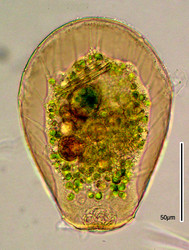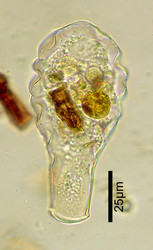Hyalosphenia
Ralf Meisterfeld and Edward MitchellIntroduction
About 20 species, type species: H. ligata (Tatem, 1870), Synonym: H. cuneata Schulze, 1875.
Characteristics
Species with compressed, chitinoid transparent shell with no foreign material; aperture often with a thickened lip. Two principal shell types: wedge-shaped or flask-shaped. All species have an ovular nucleus, some like H. papilio have a symbiosis with Zoochlorellae. The cell is fixed in the test by long epipodes (see title illustrations).
Discussion of Phylogenetic Relationships
In a first SSU rRNA-tree the genus is not monophyletic and Hyalosphenia papilio and H. elegans are mixed in a clade with Nebela spp. (Lara et al. 2008).
Ecology
The most common species of the wedge-shaped cell type is H. papilio Leidy, 1879. It is a dominant species in the green parts of wet sphagnum and therefore an excellent indicator in palaeoecological studies. H. elegans is a typical flask-shaped species, it is herbivorous and common in mosses and acid soils.
Additional ecological data: Schönborn (1962), Meisterfeld (1977), Bonnet (1989).References
Bonnet, L. 1989. Données écologiques sur quelques Hyalospheniidae et Paraquadrulidae (Thécamoebiens) des sols (Première partie). Bull. Soc. Hist. Nat. Toulouse, 125:17-22.
Grospietsch, T. 1965. Monographische Studie der Gattung Hyalosphenia STEIN, (Rhizopoda, Testacea). Hydrobiologia, 26:211-241.
Charret, R. 1964. Contribution a l'étude cytologique et biologique de Hyalosphenia papilio (Leidy), Rhizopode Testacé. Bull. Biol. France Belg., 98:369-390.
Lara, E., Heger, T.J., Ekelund, F, Lamentowicz and Mitchell, E.A.D. 2008: Ribosomal RNA Genes challenge the monophyly of the Hyalospheniidae (Amoebozoa: Arcellinida). Protist 159: 165-176.
Meisterfeld, R. 1977. Die horizontale und vertikale Verteilung der Testaceen (Rhizopoda, Testacea) in Sphagnum. Arch. Hydrobiol., 79:319-356.
Ogden, C. G. & Hedley, R. H. 1980. An Atlas of Freshwater Testate Amoebae. Oxford University Press, Oxford.
Schönborn, W. 1962. Die Stratigraphie lebender Testaceen im Sphagnetum der Hochmoore. Limnologica, 1:315-321.
Title Illustrations

| Scientific Name | Hyalosphenia papilio |
|---|---|
| Identified By | Edward Mitchell |
| Copyright |
© Edward Mitchell

|
| Scientific Name | Hyalosphenia elegans |
|---|---|
| Location | Seeon, Germany |
| Specimen Condition | Live Specimen |
| Identified By | Ralf Meisterfeld |
| Copyright |
©
Ralf Meisterfeld

|
About This Page
This page is being developed as part of the Tree of Life Web Project Protist Diversity Workshop, co-sponsored by the Canadian Institute for Advanced Research (CIFAR) program in Integrated Microbial Biodiversity and the Tula Foundation.
Ralf Meisterfeld

Rheinisch-Westfälische Technische Hochschule Aachen, Germany
Edward Mitchell

University of Neuchâtel
Correspondence regarding this page should be directed to Ralf Meisterfeld at
meisterfeld@rwth-aachen.de
and Edward Mitchell at
edward.mitchell@unine.ch
Page copyright © 2008 Ralf Meisterfeld and Edward Mitchell
All Rights Reserved.
- First online 02 September 2008
- Content changed 02 September 2008
Citing this page:
Meisterfeld, Ralf and Edward Mitchell. 2008. Hyalosphenia . Version 02 September 2008 (under construction). http://tolweb.org/Hyalosphenia/124528/2008.09.02 in The Tree of Life Web Project, http://tolweb.org/










 Go to quick links
Go to quick search
Go to navigation for this section of the ToL site
Go to detailed links for the ToL site
Go to quick links
Go to quick search
Go to navigation for this section of the ToL site
Go to detailed links for the ToL site